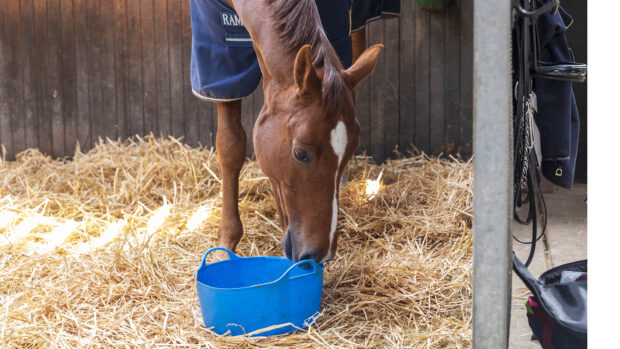When temperatures plummet, breaking ice in water buckets can be a thankless task. We investigate how to stop water buckets freezing, so that your horse always has a supply available to him…
How to stop water buckets freezing
1. “Use rubber buckets as opposed to metal or plastic ones as rubber is a good insulator and will slow down the rate of freezing. We use the rubber TugTrug ones and they are great — the bigger the bucket the better as it is less likely to freeze,” says Jess Errington, head girl to Harry Meade.

76l Flexi Buckets | Amazon.co.uk
These large buckets are available in a wide range of colours.
2. Think about the positioning of your water buckets. Placing them inside field shelters or in front of hedgerows provides a layer of insulation and will slow the water’s cooling rate and therefore delay any freezing. If the buckets are outside ensure they are situated in a place that will catch any sunlight in the daytime (if there is any!) so the water gets as much warmth as possible.
3. “Putting your bucket in a rubber tyre will help slow down the rate of freezing as will banking any bedding around the bucket in the stable. You can also sit your water bucket inside a larger bucket and then use straw or shavings to line the space between the two buckets for insulation,” adds Jess.
4. If you are using multiple buckets in a field or shelter, place them close to each other. Horses often group together to drink so this will raise the area’s temperature and slow the freezing rate.
5. Another useful tip is to fill a plastic bottle with water and a cup of salt before putting the lid on and placing it in the water bucket. The salt will prevent the water inside the bottle from freezing and the bottle will float in the water which will stop the water in the bucket from icing over.
6. “We have a water trough which the horses don’t have access to but we use to refill any buckets so we always cover that at night to save having to break the ice the next morning,” concludes Jess. “If buckets or troughs do freeze, don’t just break the ice and leave it to float in the water, take out any chunks so the water takes longer to refreeze.”
In the USA and Canada where temperatures are more extreme than in the UK there are several ways to prevent water buckets from freezing. In colder climates it is also important to have measures in place for any water taps and pipes.
7. “Heated water buckets (which are available on Amazon) — where the heater is in a sealed compartment at the bottom of the plastic bucket, so no shock can transfer — that can hang on the wall are really useful but you need to fully enclose the metal coated cord in the wall so that the horse or any rodents can’t chew it. You also need to check heated buckets more regularly and ensure they always have water in,” explains Jay Jay Rogers, who owns Gloucester Downs Equestrian Park in British Columbia in Canada where temperatures can hit -10c in the winter.

Heated Water Bucket | Amazon.co.uk
This two-gallon bucket has a thermostat so it only operates when necessary.
8. Placing a piece of wood or a well-sealed plastic jug filled with rock salt in each water barrel won’t necessarily stop it icing over but is a good tip to stop the water from freezing so hard that it breaks the barrel.
9. “Wrapping all exposed pipes with foam and silver reflective blankets helps to prevent them from freezing but I find horses tear it off if I put it around their bucket or barrel,” says Jay Jay, who has also insulated and heated the area where all her pipes meet.
10. Installing hot water tanks in your barn and hanging hoses in heated rooms ensures you always have access to water to fill up any water buckets, regardless of the temperature.
“Colic is common in horses that can’t intake enough water which is why I try to offer warm water in the cold weather,” says Jay Jay.
11. “Leaving a trickle of water running from the tap down into a drainpipe underground in the really cold weather is a good idea as running water rarely freezes,” Jay Jay adds.
12. “Back up power is a necessity for us so we have three generators that we use to keep water and water heaters running in power outages,” reveals Jay Jay. “We also have a self-draining standpipe as back up if everything else freezes up.”
- To stay up to date with all the breaking news throughout London International and more, subscribe to the Horse & Hound website
You may also be interested in:

Can goldfish help keep my horse’s water trough clean? H&H investigates…

Subscribe to Horse & Hound magazine today – and enjoy unlimited website access all year round



